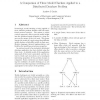Free Online Productivity Tools
i2Speak
i2Symbol
i2OCR
iTex2Img
iWeb2Print
iWeb2Shot
i2Type
iPdf2Split
iPdf2Merge
i2Bopomofo
i2Arabic
i2Style
i2Image
i2PDF
iLatex2Rtf
Sci2ools
IWFM
2000
2000
A Comparison of Three Model Checkers Applied to a Distributed Database Problem
ct Increasingly, model checking is being applied to more abstract problem domains than the traditional protocol analysis. The extent to which such an approach is able to provide useful insight into the problem domain depends to a large degree on the nature of the tool used. This paper reports the results of a study using three di erent model checkers, which di er widely in their speci cation language, internal implementation, and facilities for specifying correctness properties. act model of an industrial distributed database application has been studied using the three tools. A detailed model of the application using each of the tools is presented, and the extent to which each tool allows us to investigate interesting properties of the problem domain is compared. Some conclusions are drawn regarding the usefulness of model checking at an abstract level and the importance of selecting a tool appropriate to the nature of the problem.
IWFM 2000 | IWFM 2001 | Model | Model Checking | Problem Domain |
Related Content
| Added | 01 Nov 2010 |
| Updated | 01 Nov 2010 |
| Type | Conference |
| Year | 2000 |
| Where | IWFM |
| Authors | A. J. Currie |
Comments (0)

